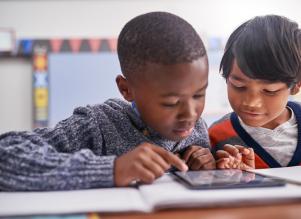4/22/2019
Teachers Need Support as They Navigate the Emerging World of Educational Technology
There is no doubt about it: Educational technology is here to stay. While much of it seems new thanks to the rapid expansion of the industry, a timeline provided by Purdue University Online shows that education and technology have been intertwined for years in one form or another. Once, only 10 percent of all students attended high school—today, that number is closer to 100 percent. Indeed, the Purdue timeline illustrates that as more and more students pursued formal education or were allowed into the fold, technological advances such as slide projectors and calculators became standard pieces of classroom apparatus.
Necessity has been the mother of invention here, and as the Purdue piece noted, the increase in expectations around education has led teachers to search for “new methods of instruction and testing” while students seek “new ways to communicate, study, and learn.” This, coupled with the growth of the internet and smartphones, has led to an ever-expanding field of tech options for the classroom, including eventual Augmented Reality or “multi-touch screen” products.
All this is a lot for individual teachers to keep track of, so in 2018, National Public Radio education reporter Anya Kamenetz tackled “one of the hottest trends in education right now”: personalized learning. In her report, Kamenetz observed that “personalized learning is the No.1 educational technology priority around the country” based on an industry survey done by the Center for Digital Education, then went on to explore what exactly personalized learning means (there is not one standard definition) and how it is being put to use by teachers.
While many teachers were “wildly enthusiastic” about the possibilities of using technology to personalize learning for their students, Kamenetz noted that “they were often left on their own.” New products and initiatives may arrive in a teacher’s classroom quite readily, but then what? This leads to a central issue with educational technology, including personalized learning: Teachers typically want to use it but can’t do so properly without more support and guidance. A 2018 post on PBS’s Teachers Lounge site tapped into this conundrum by asking “What do educators want?” before providing this response: “Educational technology support!” The reason? They, in turn, want to better support students.
The writer of the PBS piece—Kristin Carney, a former elementary school teacher working on a master’s degree in education—made it clear that while most teachers want to adopt new technology-based practices, many “do not think there is enough support” offered. According to Carney, the technology has clear promise because it, like most education innovations, has the potential to better meet individual students’ needs through targeted instruction and intervention as well as more personalized, student-driven lessons. This is an exciting frontier, to be sure, but to realize all this potential, Carney insisted that teachers must gain access to further resources and support mechanisms, including more tech-oriented professional development.
Carney went on to provide a baseline list of the kinds of support teachers are looking for, including peer-to-peer help, additional devices for adequate implementation, and greater on-site support from IT professionals. Writing for the education technology site The Journal, Joshua Bolkon also pointed out that many teachers “say they haven't received the training they need to effectively use the technology they're asked to in the classroom,” and used survey results from the STEM-focused company SAM Labs to back up his assertion. Based on responses from 250 teachers, these results indicated that although the majority of educators saw a boost in students’ skill levels through the use of educational technology—particularly in math and reading—many are seeking greater guidance in how to harness its potential.
In 2018, the Brookings Institution also covered the promise and pitfalls of implementing educational technology. Striking a cautionary tone, edtech professional Alina von Davier took on some of the challenges teachers encounter when trying to embrace tech-driven personalized learning in a piece she penned for the institution's website that included testimony from Chicago teacher Paul Emerich, who described the confusion of trying to incorporate computerized teaching and learning systems without much experience or help. “The workload was immense and unsustainable,” wrote Emerich, “and even when I felt like I was doing what we set out to do—curate educational playlists of cards that were specifically chosen for (students)—I didn’t feel like it was entirely effective.”
While not identifying one specific solution to these issues, von Davier argued that the “quality of digital instruction and its integration with teacher-led instruction is the future of education”—and most teachers and education observers would likely agree with her assessment, as it is clear that technology is not going away anytime soon. Therefore, since teachers remain a central figure in the evolution and efficacy of classroom-based technology, building a robust support system seems like an ideal thing to prioritize.


